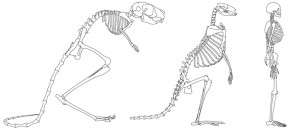Anthropologists confirm link between cranial anatomy and two-legged walking

Anthropology researchers from The University of Texas at Austin have confirmed a direct link between upright two-legged (bipedal) walking and the position of the foramen magnum, a hole in the base of the skull that transmits the spinal cord.
The study, published in a forthcoming issue of the Journal of Human Evolution, confirms a controversial finding made by anatomist Raymond Dart, who discovered the first known two-legged walking (bipedal) human ancestor, Australopithecus africanus. Since Dart's discovery in 1925, physical anthropologists have continued to debate whether this feature of the cranial base can serve as a direct link to bipedal fossil species.
Chris Kirk, associate professor of anthropology and co-author of the study, says the findings validate foramen magnum position as a diagnostic tool for fossil research and sheds further insight into human evolution.
"Now that we know that a forward-shifted foramen magnum is characteristic of bipedal mammals generally, we can be more confident that fossil species showing this feature were also habitual bipeds," Kirk says. "Our methods can be applied to fossil material belonging to some of the earliest potential human ancestors."
The foramen magnum in humans is centrally positioned under the braincase because the head sits atop the upright spine in bipedal postures. In contrast, the foramen magnum is located further toward the back of the skull in chimpanzees and most other mammals, as the spine is positioned more behind the head in four-legged postures.
As part of the study, the researchers measured the position of the foramen magnum in 71 species from three mammalian groups: marsupials, rodents and primates. By comparing foramen magnum position broadly across mammals, the researchers were able to rule out other potential explanations for a forward-shifted foramen magnum, such as differences in brain size.
According to the findings, a foramen magnum positioned toward the base of the skull is found not only in humans, but in other habitually bipedal mammals as well. Kangaroos, kangaroo rats and jerboas all have a more forward-shifted foramen magnum compared with their quadrupedal (four-legged walking) close relatives.
These particular mammals evolved bipedal locomotion and anteriorly positioned foramina magna independently, or as a result of convergent evolution, says Gabrielle Russo, who is a postdoctoral research fellow at Northeast Ohio Medical University and lead researcher of the study.
"As one of the few cranial features directly linked to locomotion, the position of the foramen magnum is an important feature for the study of human evolution," Russo says. "This is the case for early hominin species such as Sahelanthropus tchadensis, which shows a forward shift of the foramen magnum but has aroused some controversy as to whether it is more closely related to humans or African apes."
More information: www.sciencedirect.com/science/ … ii/S0047248413001681
Journal information: Journal of Human Evolution


















